Hyacinthus have a gorgeously sweet spring fragrance which pumps out into the garden on misty spring evenings. They are incredibly simple to grow, and well worth trying at home.
If you’ve never grown hyacinthus before, then follow our dedicated grow guide here for everything you need to know. We’ll be sharing hyacinth propagation tips and some specially selected varieties that are sure to grow well in any Australian garden.
More...
Family: | Asparagaceae |
|---|---|
Genus: | Hyacinthus |
Species: | Hyacinthus litwinovii Hyacinthus orientalis Hyacinthus transcaspicus |
Common Names: | Hyacinth |
Location: | Indoor or outdoor |
Type: | Flowering perennial |
Growth: | 15-30cm tall, clump forming |
Sun requirements: | Full sun or partial shade |
Foliage Colour: | Green |
Flower Colour: | White, pink or blue |
Flowering: | Early-mid spring |
Fruit: | None |
Maintenance level: | Low |
Poisonous for pets: | Flower, stems and bulbs are toxic |
What are Hyacinthus?
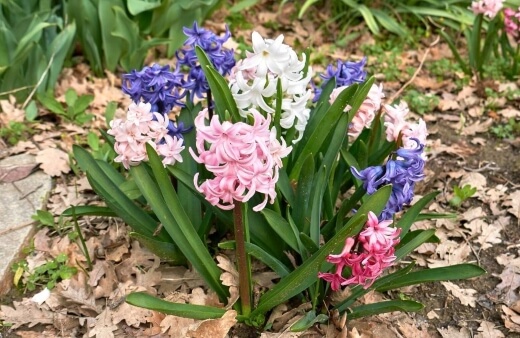
Despite their relatively common appearance in our gardens, hyacinthus are a fascinating, and by no means common plant. Their etymology alone is engrossing, with just three clear species, despite being amongst the oldest of all recorded plants.
While they bear no relation to the Greek god Hyacinthus, Homer, the Greek philosopher noted them as hyakinthos (or ‘plant’). Though later studies revealed that this variation was in fact a Scilla, future translations passed on to the common oriental hyacinth which kept the name.
Today, there are three known Hyacinthus species, none of which derived from Greek origins. Their leaves spread up from a central bulb, producing a single blousy flower spike, covered in blue, white or pink flowers (though recent cultivars are gradually being bred into reds and beautiful purples).
These hardy bulbous perennials flower in spring, and can be planted indoors at any time of year for an early winter display.
Hyacinth’s Natural Habitat
Hyacinths are most commonly found growing wild in Europe and Asia, but are well adapted to most mild climates and are easily naturalised throughout much of the world today.
All three species of hyacinth, including Hyacinthus orientalis, are native to Turkey, Iran and Syria with some occurrences in Israel. Though, like most species titles, they are inaccurately described by early British explorers who had a habit of mislabelling places, people, and territories.
As you would expect from these eastern Mediterranean climates, hyacinthus prefer well-drained soil and full sun, though we find that they perform well in cooler climates, and will bloom pretty much anywhere provided the soil can drain in summer and they aren’t left to sit in moisture over winter.
Hyacinth Species Guide
There are just three recognised species of hyacinth, each with key variations in flower height and leaf form, but they all grow in the same conditions.
The majority of hyacinths we grow in Australia are Hyacinth orientalis, but keen collectors often prize H. litwinovii and H. transcaspicus for their more delicate foliage.
Hyacinthus litwinovii
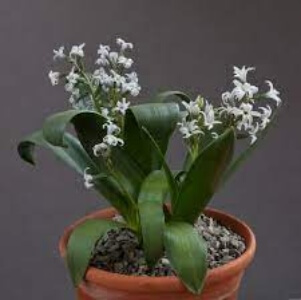
Source: encyclopaedia.alpinegardensociety.net
H. litwinovii is a delicate species, with looser flower heads and broader foliage that grows to an ultimate height of around 10-15cm making it a distinctly compact hyacinth. Its fragrance is similar to the larger common hyacinths, but with led nectar production.
Litwinovii grows best in well-drained pots with regular watering and a surface mulch of gravel or grit to protect foliage from splash damage.


Get Your Free Guide:
Master Growing Australian Natives eBook
A Must Have Complete Guide for Every Australian Garden
Get Your Free Guide:
Master Growing Australian Natives eBook
A Must Have Complete Guide for Every Australian Garden
Growing them in individual display containers also makes them more visible as they get easily lost under other planting in spring.
Hyacinthus orientalis

Also known as the common hyacinth, garden hyacinth or Dutch hyacinth, H. orientalis is the variety that most gardens will be familiar with.
Their thick leaves clump together in gardens, shooting out of the soil in late winter and flowering reliably in early spring. They like moist but free-draining soil, and perform best in full sun.
H. orientalis are also the easiest species to grow indoors for winter displays, though the entire plant is poisonous to pets.
Hyacinthus transcaspicus
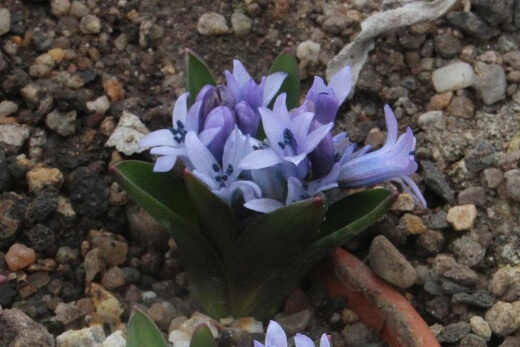
Source: garden.org
H. transcaspicus are beguilingly beautiful and have a glorious fragrance despite their diminutive size. Their sparse, narrow leaves spread flat along the ground, with double flower spikes emerging together in early winter.
Transcaspicus generally have several pale-blue upright flowers on each stem, with pointed leaves that curl in on themselves to catch rainwater which is channelled back towards the bulb.
10 Best Hyacinthus to grow in Australia
1. Hyacinthus orientalis ‘Pink Surprise’There is no other hyacinth that can compete with Hyacinthus ‘Pink Surprise’ on delicacy in a soft traditional border planting style. The highly ornamental blooms of the Hyacinthus ‘Pink Surprise’ have deep pink detailing on each petal, with a soft bell-shaped flower, clustered in a dense group along a single flower spike. |  Source: juniperhillgreenhouses.com |
2. Hyacinthus orientalis ‘Lady Derby’Hyacinthus ‘Lady Derby’ is typically described as pink, but in most gardens it will flower to a rosy peach colour, on short, neat, stubby foliage that acts as a perfect cup, holding the substantial blooms in place at the earliest possible window. Hyacinthus ‘Lady Derby’ flowers in late winter, or very early spring, so it is a great way to add colour to the garden before anything else is awake. | 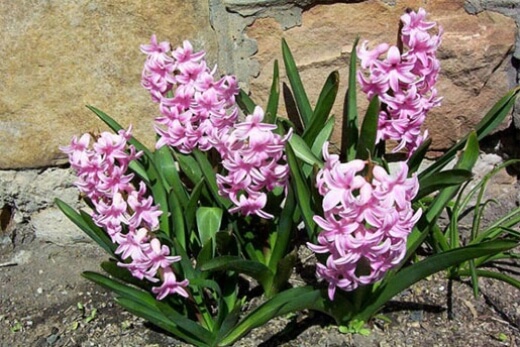 Source: landscape-service.com |
3. Hyacinthus orientalis ‘Splendid Cornelia’The dusty lilac flowers of Hyacinthus ‘Splendid Cornelia’ are an ideal accompaniment for spring flowering lilacs, which in most gardens will pair up and flower at the same time, with similar flower forms held above these bolshie blooms. The foliage is rounded with a titanium blue hue and hides the flowers until they are ready to open, making it a perfect surprise when you walk out to a wall of fragrance. | 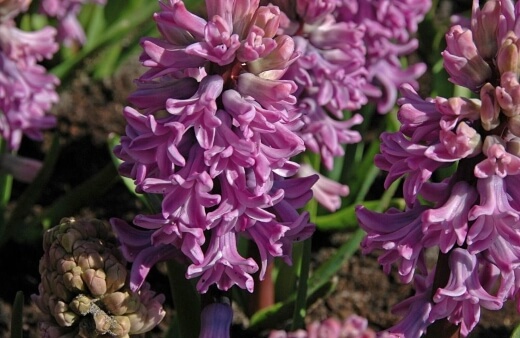 |
4. Hyacinthus orientalis ‘White Festival’There are plenty of white hyacinths that you can grow at home, but none compare to Hyacinthus ‘White Festival’, with a pure white that you just won’t find in other cultivars. The pale green stems add to the mystique and delicacy of the floaty blooms that stand tall above their bulbs. What’s even better about Hyacinthus ‘White Festival’ is that they don’t produce a single flower stalk, and often produce as many as six flower stalks per bulb in spring, creating a dense cloud of white petals hanging over the soil in spring. | 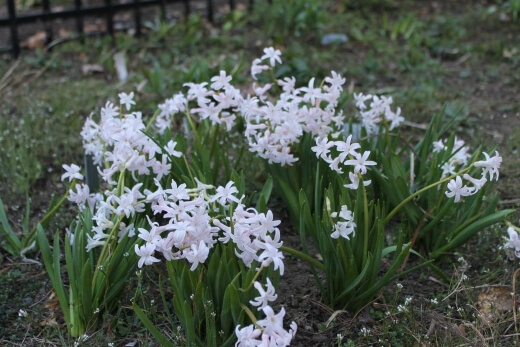 Source: garden.org |
5. Hyacinthus orientalis ‘Blue Jacket’These tall hyacinths flower at around 30cm tall, making them one of the most impactful hyacinths you can grow here in Australia. Their sturdy foliage helps to protect them from sudden shifts in the weather too, making them incredibly reliable spring flowers for any garden. While they might seem like typically blue hyacinths from afar, up close they have a delicate blue flash down the centre of each petal, cased with baby blue borders. | 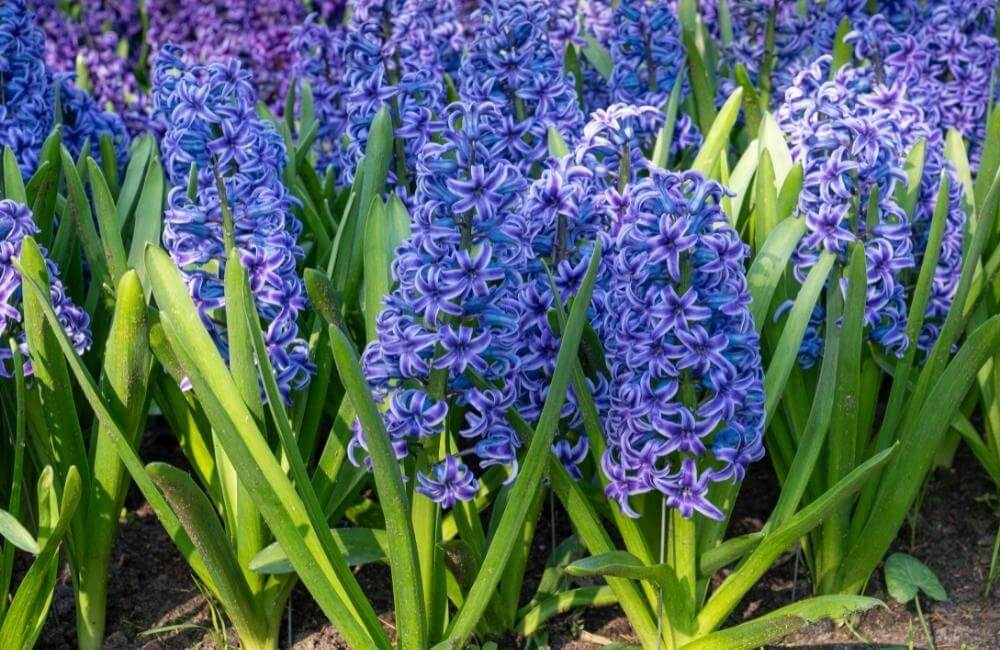 |
6. Hyacinthus orientalis ‘Dark Dimension’There are no truly black flowers in nature, but Hyacinthus ‘Dark Dimension’ is about as close as you can get. Its deep purple petals have such dark flashes down the centre of each petal that they appear almost jet black in most lights. They look beautiful paired with dark violas in late winter. | 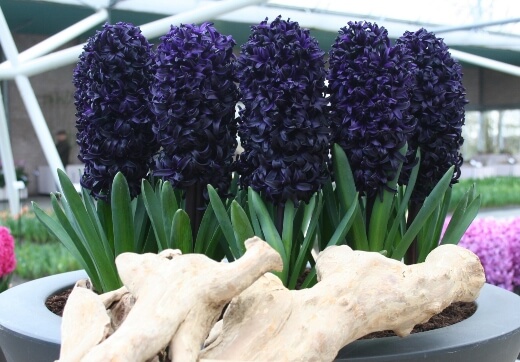 Source: dutchgrown.com |
7. Hyacinthus orientalis ‘Miss Saigon’Bright violet flower spikes burst out of grass-green leaves in early spring, making Hyacinthus ‘Miss Saigon’ one of the most dramatic spring border plants in any garden border arrangement. They also flower very well indoors, and can be easily fooled into a mid-winter flowering through light deprivation. | 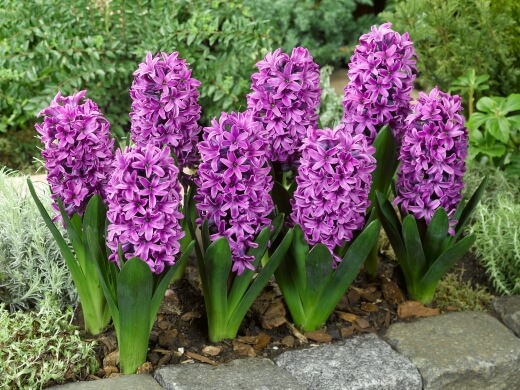 Source: jparkers.co.uk |
8. Hyacinthus orientalis ‘Purple Sensation’These stubby dwarf hyacinths are Hyacinthus ‘Purple Sensation’, growing to just 10cm at their very most, they work well as spring bedding plants, or in tightly planted containers, where they form a dense mat of even purple blooms for high impact on the patio. Grow them in full sun, with a gritty compost mix to provide excellent drainage to avoid dense arrangements from growing waterlogged. |  Source: bluestoneperennials.com |
9. Hyacinthus orientalis ‘Woodstock’We’ve had some trouble growing Hyacinthus ‘Woodstock’ in recent years, as the bulbs all seem to have reverted to a looser flower form with less dense blooms. However, if you get them right, they are stunning purple, elongated pompoms that can catch your eye and pull you to the further corners of the garden for a quick glimpse. | 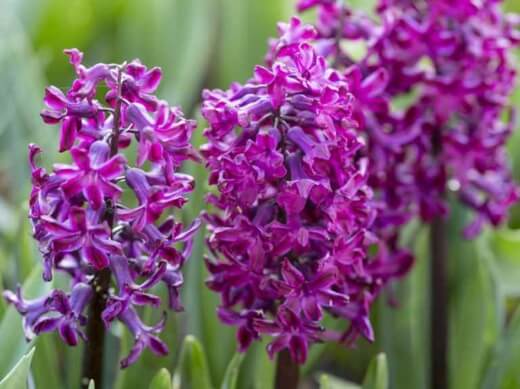 Source: gardenersworld.com |
10. Hyacinthus orientalis ‘Delft Blue’If you don’t have a green thumb, try growing Hyacinthus ‘Delft Blue’. They are foolproof plants that will cope in most conditions other than boggy soil. Their glossy green leaves reliably protrude from the soil in late winter, and within a few weeks, they will bloom on masses. |  Source: adrbulbs.com |
1. Hyacinthus orientalis ‘Pink Surprise’

Source: juniperhillgreenhouses.com
There is no other hyacinth that can compete with Hyacinthus ‘Pink Surprise’ on delicacy in a soft traditional border planting style. The highly ornamental blooms of the Hyacinthus ‘Pink Surprise’ have deep pink detailing on each petal, with a soft bell-shaped flower, clustered in a dense group along a single flower spike.
2. Hyacinthus orientalis ‘Lady Derby’

Source: landscape-service.com
Hyacinthus ‘Lady Derby’ is typically described as pink, but in most gardens it will flower to a rosy peach colour, on short, neat, stubby foliage that acts as a perfect cup, holding the substantial blooms in place at the earliest possible window.
Hyacinthus ‘Lady Derby’ flowers in late winter, or very early spring, so it is a great way to add colour to the garden before anything else is awake.
3. Hyacinthus orientalis ‘Splendid Cornelia’

The dusty lilac flowers of Hyacinthus ‘Splendid Cornelia’ are an ideal accompaniment for spring flowering lilacs, which in most gardens will pair up and flower at the same time, with similar flower forms held above these bolshie blooms.
The foliage is rounded with a titanium blue hue and hides the flowers until they are ready to open, making it a perfect surprise when you walk out to a wall of fragrance.
4. Hyacinthus orientalis ‘White Festival’

Source: garden.org
There are plenty of white hyacinths that you can grow at home, but none compare to Hyacinthus ‘White Festival’, with a pure white that you just won’t find in other cultivars. The pale green stems add to the mystique and delicacy of the floaty blooms that stand tall above their bulbs.
What’s even better about Hyacinthus ‘White Festival’ is that they don’t produce a single flower stalk, and often produce as many as six flower stalks per bulb in spring, creating a dense cloud of white petals hanging over the soil in spring.
5. Hyacinthus orientalis ‘Blue Jacket’

These tall hyacinths flower at around 30cm tall, making them one of the most impactful hyacinths you can grow here in Australia. Their sturdy foliage helps to protect them from sudden shifts in the weather too, making them incredibly reliable spring flowers for any garden.
While they might seem like typically blue hyacinths from afar, up close they have a delicate blue flash down the centre of each petal, cased with baby blue borders.
6. Hyacinthus orientalis ‘Dark Dimension’

Source: dutchgrown.com
There are no truly black flowers in nature, but Hyacinthus ‘Dark Dimension’ is about as close as you can get. Its deep purple petals have such dark flashes down the centre of each petal that they appear almost jet black in most lights. They look beautiful paired with dark violas in late winter.
7. Hyacinthus orientalis ‘Miss Saigon’

Source: jparkers.co.uk
Bright violet flower spikes burst out of grass-green leaves in early spring, making Hyacinthus ‘Miss Saigon’ one of the most dramatic spring border plants in any garden border arrangement.
They also flower very well indoors, and can be easily fooled into a mid-winter flowering through light deprivation.
8. Hyacinthus orientalis ‘Purple Sensation’

Source: bluestoneperennials.com
These stubby dwarf hyacinths are Hyacinthus ‘Purple Sensation’, growing to just 10cm at their very most, they work well as spring bedding plants, or in tightly planted containers, where they form a dense mat of even purple blooms for high impact on the patio.
Grow them in full sun, with a gritty compost mix to provide excellent drainage to avoid dense arrangements from growing waterlogged.
9. Hyacinthus orientalis ‘Woodstock’

Source: gardenersworld.com
We’ve had some trouble growing Hyacinthus ‘Woodstock’ in recent years, as the bulbs all seem to have reverted to a looser flower form with less dense blooms.
However, if you get them right, they are stunning purple, elongated pompoms that can catch your eye and pull you to the further corners of the garden for a quick glimpse.
10. Hyacinthus orientalis ‘Delft Blue’

Source: adrbulbs.com
If you don’t have a green thumb, try growing Hyacinthus ‘Delft Blue’. They are foolproof plants that will cope in most conditions other than boggy soil.
Their glossy green leaves reliably protrude from the soil in late winter, and within a few weeks, they will bloom on masses.
How to Grow Hyacinthus in Australia
Hyacinthus needs very little care and will bloom reliably every year in most climates. After a few years, the original bulb you planted will fade and stop flowering, but by then it will have duplicated underground to form dozens of new plants.
Follow our hyacinth grow guide below to get the most from these stunning bulbs.
Planting Hyacinthus Outdoors
Hyacinthus grow best outdoors, where seasonal rhythms keep them to a regular flowering cycle, and live dormant in the soil through winter after their flowers and foliage die back to help bulbs reproduce underground.
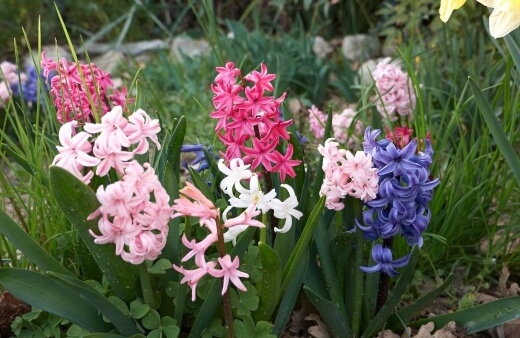
Soil & Drainage
Aim to provide a fertiliser but free-draining soil. The soils of the eastern Mediterranean, where hyacinthus are native, are packed with nutrients and minerals but extremely free-draining.
Aim to replicate that in your own garden. Sandy soils, mixed with fresh compost are ideal.
Depth
Plant seeds at 3x their own depth. Large hyacinth bulbs from H. orientalis are generally about 5cm tall, so need a planting hole that is 15cm deep.
Use a dibber if your soil is loose, but for compacted soils, dig the entire area and lay hyacinth bulbs around 10cm apart, then cover with a loose sandy compost mix. This allows bulbs to spread without compaction.
Watering Hyacinth
While hyacinthus like free draining soil, they are thirsty plants when it comes to flowering time. Seasonal weather changes will usually be enough for hyacinth to bloom, with wetter winters and springs helping to feed the young bulbs, but in dry springs, water them heavily once a week.
Light Requirements
Hyacinthus needs full sun. They can bloom in partial shade, but not with the vigour of those in a brighter spot, so aim to plant them right at the front of borders and avoid spring competition from daffodils or tulips that grow taller and will shade them out.
What Fertiliser to Use
If you’ve got badly drained clay soil, then add sand to your planting spot, and avoid compost which will increase water retention further. Instead, use horticultural sand mixed with slow release fertiliser that won’t add to the drainage problem.
Growing Hyacinthus in Containers
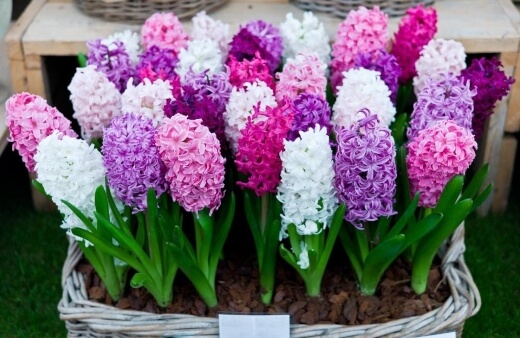
If you like to keep your gardening contained and above ground, then hyacinthus are ideal. They grow well in containers and are better adapted than most spring bulbs to cope with the heightened drainage.
Pots and planters drain faster than garden beds, so will need watering more in late winter when foliage pops out of the ground, but other than that, growing hyacinthus in containers is exactly the same as growing them in the ground.
Opt for terracotta pots, which help to improve drainage even further.
Growing Hyacinthus Indoors
By growing hyacinthus in a simple container indoors, they will usually flower a few weeks earlier than in outdoor pots. However, hyacinth flower based on shorter day length and low light levels so can be triggered into flowering at any time of year indoors, but it does take some work.
To trigger hyacinthus into flower:
- Plant hyacinth bulbs half submerged in soil, and half exposed to light, making sure the root plate is pointed down
- Water the soil and allow it to drain
- Place the pot in a dark cupboard for 2-3 months, regularly checking to ensure the soil is still moist
- When leaves begin to emerge, bring your plants into a bright room and water them regularly
- They should flower about 2 weeks later
- After flowering, let the foliage and flower spikes die back
- Finally, lift the bulbs and dry them at room temperature
- Store them somewhere cool and dark, then plant them into the garden in the autumn for a spring display
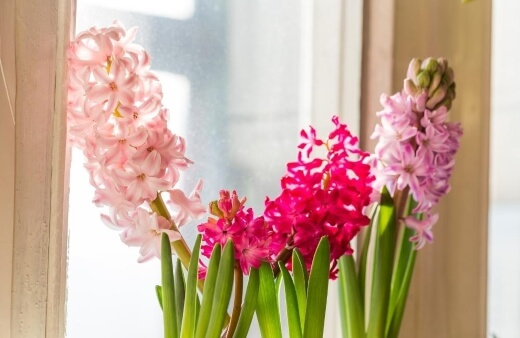
Growing Hyacinths in water
While hyacinthus like good drainage, they can look beautiful in a single vase, planted in nothing but water. You will need a special hyacinth vase though, which keeps individual bulbs from becoming submerged but allows their roots to reach into the water.
Follow the same steps as above for indoor planting and light blocking, but rather than planting in soil, balance a single bulb in each vase and change the water regularly until leaves emerge from the bulb.
After flowering, allow everything to die back to feed the bulb. If you cut the foliage back completely the bulb is unlikely to flower again, so let nature take its course, and then plant the bulb into the garden where it will die back, and hopefully duplicate for a floral display next year.
How to Propagate Hyacinths
Propagating Hyacinths from seed
Growing hyacinthus from seed takes time, but is worth the effort if you want to create new plants for less money. The only downfall of hyacinth seeds is that you can never 100% guarantee the colour you’ll get, because they cross-pollinate so easily.
Tools:
- Seed compost
- Seed module tray
- Paper towels
- Polythene bag
- Fridge
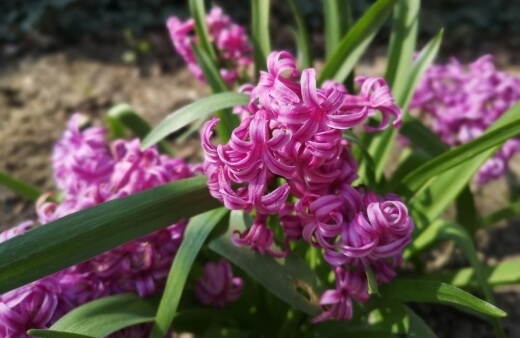
Method:
(optional, but advised) Lay seeds on a damp paper towel, and place inside a sealed polythene bag. Place the bag in the fridge for 2-3 weeks. Once sprouted, gently plant them in individual modules in a seed tray.
This helps to trigger the seeds in the same way as winter would outdoors. Otherwise:
- Fill a seed module tray with free draining seed compost
- Plant individual hyacinth seeds, one per module
- Water well, and cover them with a sheet of plastic or glass
- Store in a bright greenhouse, cold frame, or windowsill
- Seeds will take 3-4 weeks to germinate
- Water them when the modules dry out for the first year
- Young hyacinths will develop foliage in their first year, and can be potted up into individual small pots when they are big enough
- When the foliage dies back, bulbs begin to form, and your seedlings can be planted out, ready to flower in the second year.
Tip: To save hyacinth seeds from your own garden, simply wrap a bag, or a pair of old tights, around the flower head when it begins to dry off.
Plant them as soon as they fall, or store them in a cool, dry, dark place in a paper envelope for up to three years.
Growing Hyacinths from Bulbs
Hyacinthus are best grown from bulbs and can be purchased cheaply online or from garden centres in the autumn. The best time of year to plant hyacinth bulbs is mid-to-late autumn, but they will often flower from late plantings in winter if you spot any reduced bulbs.
Simply plant them at 3x their own depth in free draining fertile soil, either in the garden or in containers. Then water and wait.
Hyacinths Propagation from Division
Healthy hyacinthus will duplicate their bulbs every year, often forming four new plants for each central bulb. This is ideal for the first two or three years, when just one packet of bulbs can multiply into a full border worth of plants.
However, after three years the bulbs will be competing for nutrients, light, and space, so need dividing. Dig up clumps of hyacinths after they have finished flowering, and plant them elsewhere in the garden.
Add compost into empty gaps, and then water the new clump wherever it is planted. Both the original clump and moved section will flower again next year.
Hyacinthus Care Tips
You can treat hyacinthus as low maintenance plants, and you’ll still receive a spring display, but with a little bit of extra care and attention you can vastly improve the fragrance, flower height, and length of their display next year.
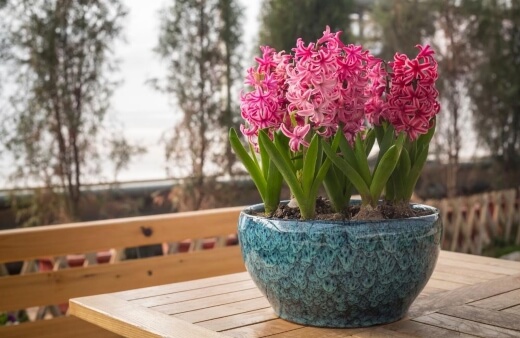
Mulching
A light mulch (no thicker than 1”) of leaf mould or standard garden compost in winter will bring flowering forward by about a week, and feed your hyacinths.
It helps to block light, triggering blooms faster in spring, and also adds nutrients to spent soi. Click here to find out more about mulching, their types, and how to use them in your garden.
Hyacinthus Fertiliser
If you don’t want to change the flowering times or risk creating damp conditions by mulching, then sprinkle a small amount of granular fertiliser or chicken manure around the bed.
Feeding hyacinthus isn’t necessary but will improve bulb health by feeding foliage, which later dies back to feed the bulb.
Repotting
As hyacinths mature they develop new bulbs from their parent bulb, and will outgrow containers pretty quickly. Re-pot hyacinths after two years, or divide the contents of each pot to make room for more new bulbs.
New bulbs flower better than old bulbs, and eventually the original bulb will stop flowering, so it’s important to re-pot hyacinthus every one to two years.
Deadheading Hyacinths
Like most bulbous perennials, hyacinths flower better the following year if you deadhead them after flowering. As the flowers begin to fade, they put energy into producing seeds.
By removing spent flowers, you stop the bulb wasting its energy, and the foliage will begin to die back and feed the bulb, rather than wasting energy on seeds.
If you want to extend your stock of hyacinthus by collecting seeds, then leave one or two flower heads to ripen.
Common Hyacinth Pests and Diseases
Hyacinthus are pretty much pest-free thanks to high toxicity and their short seasons, which means they usually beat most common garden pests to the punch in spring.
Squirrels and rodents
Despite being toxic to them, rodents seem to love hyacinths. For obvious reasons, the problem tends not to persist after rodents have dug up and eaten a bulb.
Generally, rodents are sensible enough to steer clear, but those who don’t are self-controlling.
Slugs
Hyacinthus in damp soil will be eaten by slugs, the only way to stop it is to improve drainage or move hyacinths to a better position where they develop stronger growth that is less attractive to slugs, which prefer to munch on plump foliage from waterlogged plants.
Hyacinthus are tough plants, but damp soil can cause problems, as well as overly dense planting. The best way to avoid fungal or bacterial damage to your hyacinths is to plant them properly, in free draining soil, and regularly divide plants to avoid overcrowding.
Botrytis blight
Botrytis blight, like most blights, affects the leaves or hyacinths first. It forms yellow spots, which develop brown centres and a target pattern of brown, white and yellow as it develops.
Later, these spots will connect to cover leaves, and can spread to flowers and buds, preventing them from opening and causing a mould that prevents flowering.
Remove and burn the foliage and flowers of any affected plants when you spot the signs of botrytis blight on hyacinths as it can spread to other parts of the garden.
Soft rot
Erwinia carotovora, or soft rot, is a bacterial infection that spreads between bulbs. It causes foliage to damp off and rot, which flowers can fail to develop at all.
If you notice soft-rot on hyacinths, remove the bulbs as soon as possible and dispose of them. Remove affected foliage that will exacerbate the problem too. As you dig up bulbs they will have a strong rotten odour.
Hyacinthus planted in well-drained soil rarely suffer from this condition.
Hyacinthus Frequently Asked Questions
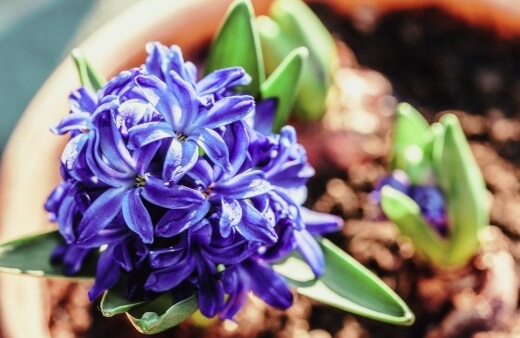
Are grape hyacinths the same as hyacinths?
Despite their similar foliage, and upright flower spike, grape hyacinths are not hyacinths. They are the main cultivar of the species Muscari, and grow well in partial shade and slightly damper conditions than hyacinths.
What do you do with hyacinth bulbs after they bloom?
There are a few ways to support hyacinth bulbs after blooming. You can either dig them up and dry them once foliage has died back, where they will store reliably well in cool, dark, and dry conditions right through summer and autumn.
Or, simply leave them in the ground to flower in the same place next year.
Do hyacinths multiply?
Hyacinthus multiplies very efficiently, producing 3-4 new plants for each bulb every year. The original bulbs will stop flowering after a few years, but its offspring will continue blooming and produce new bulbs to flower into the future.
Can I plant hyacinth bulbs in spring?
The best time to plant hyacinth bulbs in the garden is autumn, but you can still plant bulbs well into late winter, and even early spring provided they have been stored somewhere dark and dry over winter.
They won’t flower as well in their first year, but will produce foliage and a small floral display, followed by a full display in their second year.
Start Growing Hyacinthus and Add Some Fresh Aroma in Your Garden
Hyacinthus are incredibly easy to grow in almost every part of Australia, provided you give them plenty of sunlight, good drainage, and enough water in late winter. Whether you’re growing Hyacinth indoors or out, you can’t go wrong if you follow those simple rules.
There aren’t many flowers that can evoke spring in quite the same way as a hyacinth thanks to its sugary fresh aroma. Now you know how to grow hyacinthus, you’ll have that scent all over the garden and spilling into the house for years to come.
Published on August 26, 2022 by Maisie Blevins
Last Updated on October 4, 2024




